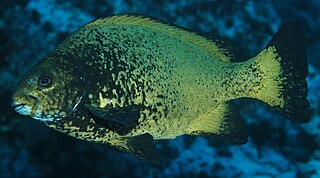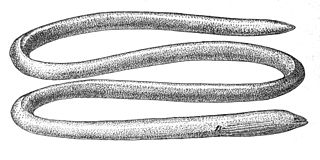
The sea chubs, also known as rudderfish and pilot fish and in Hawaiian as enenue or nenue, are a family, Kyphosidae, of fishes in the order Perciformes native to the Atlantic, Indian and Pacific Oceans usually close to shore in marine waters.

The Moringuidae are a small family of eels commonly known as spaghetti eels or worm eels, although the latter name is also shared with other families of eels.

Lobocheilos is a genus of fish in the family Cyprinidae native to Asia.

Pseudupeneus is a genus of goatfishes native to the Atlantic Ocean and the eastern Pacific Ocean. They inhabit mainly the coastal waters of continental shelves, but can be found in deep waters, as well.

Cyclocheilichthys is a genus of ray-finned fish in the family Cyprinidae containing approximately nine valid species. They are native to freshwater habitats in Southeast Asia and China.

Puntioplites is a genus of freshwater ray-finned fish belonging to the family Cyprinidae, the family which includes the carps, barbs, minnows and related fishes. The fishes in this genus are found in eastern Asia.
Chilorhinus is a small genus of marine ray-finned fishes belonging to the family Chlopsidae, the false morays. These eels occur in tropical waters
Neoconger is a genus of eels of marine ray-finned fishes belonging to the family Moringuidae, the spaghetti eels. These eels occur in shallow tropical and subtropical waters.

Cirrhimuraena is a genus of eels in the snake eel family Ophichthidae.
Yirrkala is a genus of eels in the snake eel family Ophichthidae. It is named after Yirrkala, an indigenous community in Arnhem Land, in the Northern Territory of Australia.

Bangana is a genus of fish in the family Cyprinidae, the carps and minnows. It is distributed across much of southern and eastern Asia. Species live mainly in the flowing waters of tropical and subtropical rivers.

Osteochilus is a genus of freshwater ray-finned fish belonging to the family Cyprinidae, the family which includes the carps, barbs, minnows and related fishes. The fishes in this genus are mainly found in Southeast Asia with a few extending into adjacent parts of China.

Schismatorhynchos is a genus of freshwater ray-finned fishes eblonging to the family Cyprinidae, the family which includes the carps, barbs, minnows and related fishes. The fishes in this genus are found on Sumatra and Borneo in Indonesia and East Malaysia.

Thynnichthys is a genus of freshwater ray-finned fish belonging to the family Cyprinidae, the family which also includes the carps, barbs, minnows and related fishes. The fishes in this genus are found in southern Asia from India to Borneo.

Ablabys is a genus of marine ray-finned fishes, waspfishes belonging to the subfamily Tetraroginae, which is classified as part of the family Scorpaenidae, the scorpionfishes and their relatives. The fishes in this genus are found in the Indian Ocean and the western Pacific Ocean.

Myrophinae, the worm eels, is a subfamily of ray-finned fishes belonging to the family Ophichthidae, which also includes the snake eels in the subfamily Ophichthinae.

Taeniamia is a genus of cardinalfishes native to the Indian Ocean and the western Pacific Ocean.

Iniistius is a genus of wrasses native to the Indian and Pacific Oceans.

Scorpaeninae is a subfamily of ray-finned fish belonging to the family Scorpaenidae in the order Scorpaeniformes, it includes the scorpionfishes, the lionfishes and turkeyfishes. They bear venomous spines in the anal, dorsal and pelvic fins which can cause severe pain in envenomated humans. The subfamily is distributed in the tropical and temperate seas around the world.

Cyclocheilos is a genus of freshwater ray-finned fishes belonging to the family Cyprinidae, the family which includes the carps, barbs and related fishes. This fishes in this genus are found in Southeast Asia.

















